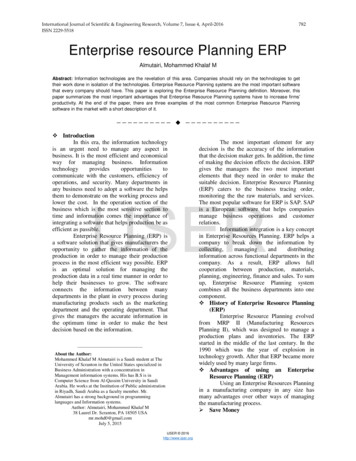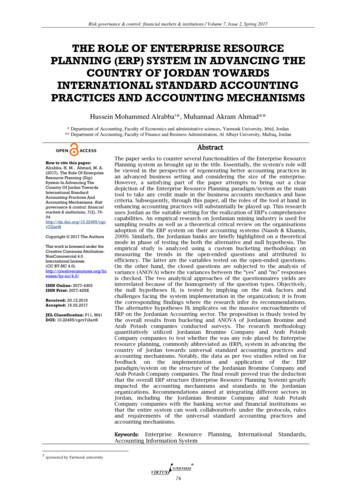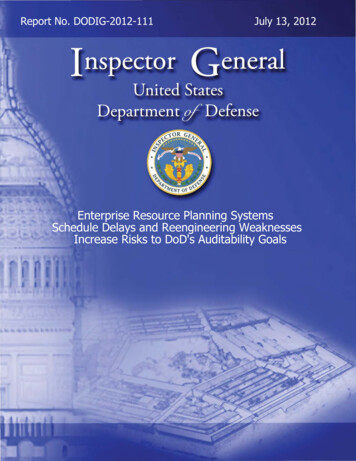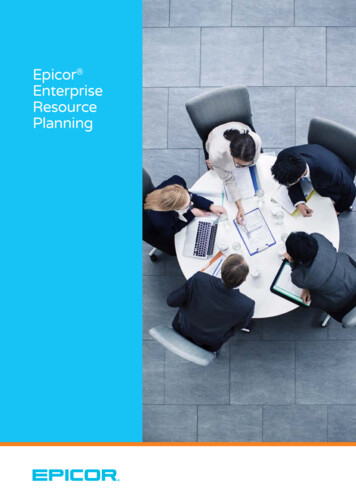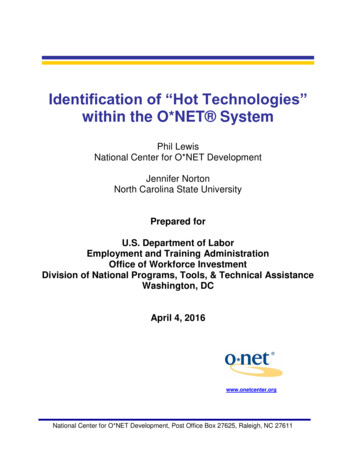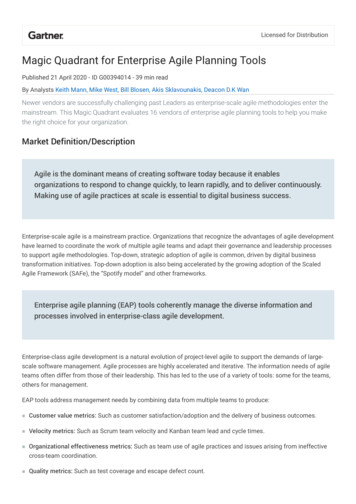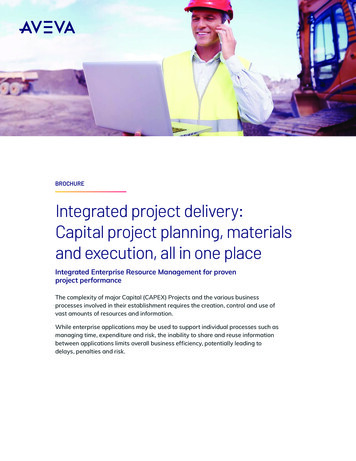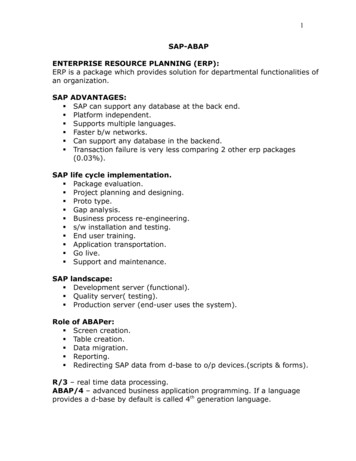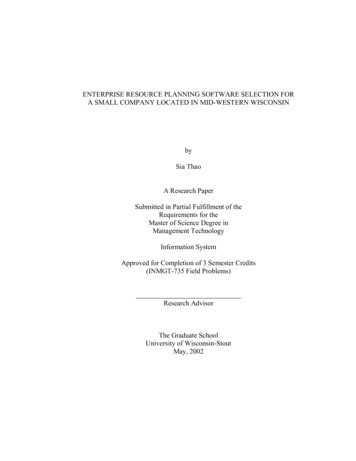
Transcription
ENTERPRISE RESOURCE PLANNING SOFTWARE SELECTION FORA SMALL COMPANY LOCATED IN MID-WESTERN WISCONSINbySia ThaoA Research PaperSubmitted in Partial Fulfillment of theRequirements for theMaster of Science Degree inManagement TechnologyInformation SystemApproved for Completion of 3 Semester Credits(INMGT-735 Field Problems)Research AdvisorThe Graduate SchoolUniversity of Wisconsin-StoutMay, 2002
ERP Software Selection2The Graduate SchoolUniversity of Wisconsin-StoutMenomonie, WI 54751ABSTRACT(Writer)Thao(Last Name)Sia(First)(Initial)Enterprise Resource Planning Software Selection For a Small Manufacturing(Title)Company Located in Mid-Western WisconsinInformation System(Graduate Major)Jim Keyes(Research Advisor)May, 2002(Month/Year)54(No. of Pages)American Psychological Association(Name of Style Manual Used in this Study)With modern technology and the birth of Enterprise Resource Planning (ERP), themanufacturing industry is in much better shape than ever before. But with rapid changesin technology, organizations must be able to keep up with the changes in order to positionthemselves at the competitive edge. However, the process of implementing an ERPsystem is not easy. The process involves early planning prior to the implementation andit is also very costly. Many implementation projects have failed due to lack of priorplanning, employee commitment, and choosing the wrong ERP system.This study will analyze a list of the available ERP software and makerecommendations on a final three ERP software options for a small manufacturingcompany located in Mid-Western Wisconsin to upgrade its ERP system.
ERP Software Selection3Table of ContentsItemsPageAbstract2Table of Contents3List of Figures4Chapter 1 IntroductionPurpose of ResearchBackground of the problemResearch Question5567Chapter 2 Literature ReviewWhat is ERP?Reasons for Acquiring an ERP SystemReasons Why ERP Implementation FailERP Future Outlook88141518Chapter 3 Research MethodologiesBackground Information on SoftSelect System, LLCProceduresPhase 1 Determining the top ten qualifying candidatesPhase 2 Narrowing down the choices to top three candidates2020212123Chapter 4 Results, Conclusion and Recommendation25Chapter 5 Summary28Bibliography30Appendix A31Appendix B35Appendix C42Appendix D44Appendix E47Appendix F50
ERP Software Selection4List of FiguresFigurePage1The Evolution of ERP102ERP Sophistication Hierarchy123Comparison of the three categories of ERP software candidates25
ERP Software Selection5Chapter 1IntroductionCertainly in today’s world industrial technology has had a major impact on everyorganization. Whether it is a small or large organization, being competitive is the key tosuccess. Before the 1990s, every department within an organization had its own storageof information, which could not be accessed by any other departments. The sharing ofinformation was not a very common concept; one department may have had no idea as towhat was going on in the other departments. Information was transferred from onedepartment to another, which involved the risk of information being misplaced, lost, orincorrectly entered into another system. This created a very hectic situation for both theemployees as well as the customers, especially in situations where the employees wantedto track down the customer’s order.With the rise of Enterprise Resource Planning (ERP) the loss of information aswell as the sharing of information is no longer the issue. The ERP system enablesemployees to share information across the whole organization and also update theinformation as changes are being made. But since technologies are advancing so rapidly,it is very critical that every organization has the ability to adapt to changes in order tostay competitive.Purpose of ResearchThe purpose of this research project is to make the final recommendation on thetop three ERP software packages that will best meet the needs of a small manufacturingcompany located in Mid-Western Wisconsin. For confidential purposes the name of thiscompany will not be stated in this project, but it will be referred to as Company ABC.
ERP Software Selection6Background of The ProblemCompany ABC is a small, independent, privately owned manufacturing companythat has been passed down four generations. The company has successfully been inbusiness for over 100 years. It is now a very well known company with a reputation forthe highest standard of efficiency in its product manufacturing. The company has a totalof 55 employees and carries two product lines, which are sold worldwide. CurrentlyCompany ABC operates its daily business activities using a system called EffectiveManagement System (EMS). Company ABC uses the EMS system to help manage itsinventory, particularly with the reorder point. In addition, the EMS system is also usedfor doing the Bill of Material (BOM) routing, shop floor control, costing, and accounting,such as accounts receivable and accounts payable. The company has been using thisEMS system for approximately 10 years and is thinking about switching to a new ERPsystem that would help the company to operate more efficiently and effectively. Sincethere are two separate systems for both the Engineering department and the InformationSystem department, the most important feature that Company ABC would like to see in anew ERP system is the ability to link the engineer’s database to the Information System’sdatabase. More accurate costing, such as automatic updating versus manual updating ofthe customers’ records is another feature that the company is looking for. Finally, a thirdfeature is the product’s capabilities for managing field services. Due to these highlycritical features, Company ABC would like to have a new ERP system that include allthree features as well as other functional capabilities that would lead to overallorganizational improvement.
ERP Software SelectionResearch QuestionHow can we find the top three most updated ERP software packages that fallwithin a limited range of software cost for a specific number of users that would bestmeet the needs of company ABC?7
ERP Software Selection8Chapter 2Literature ReviewWhat is ERP?ERP is the acronym for Enterprise Resource Planning. It is a new informationsystem that was developed in the 1990s as a result of the various business decisionsupport systems incorporated in to the Manufacturing Resource Planning (MRP II)system (Kapp, Latham & Ford-Latham, 2001, p. 22). Enterprise Resource Planning isdefined as:An enterprise-wide set of management tools that balances demand and supply,containing the ability to link customers and suppliers into a complete supplychain, employing proven business processes for decision-making, and providinghigh degrees of cross-functional integration among sales, marketing,manufacturing, operations, logistics, purchasing, finance, new productdevelopment, and human resources, thereby enabling people to run their businesswith high levels of customer service and productivity, and simultaneously lowercosts and inventories; and providing the foundation for effective e-commerce(Kremzar & Wallace, 2001, p. 5).In similar fashion, Kapp, Latham & Ford-Latham (2001) defined ERP as “a system ofintegrated procedure, rules and algorithms designed to function consistently time andtime again” (p. 85).However, different people may interpret ERP differently, but the key point in anERP system is integration. The purpose of ERP is to create a single computer system thatcan perform all of the functions of every department within an organization by linking all
ERP Software Selection9of the departments into one single database. With the integration of a single database, itenables everyone within different functional areas to share the same information as wellas communicate with one another. “What ERP really does is organize, codify, andstandardize an enterprise’s business processes and data. The software transformstransactional data into useful information and collates the data so that it can be analyzed”(Norris, Hurley, Hartley, Dunleavy & Balls, 2000, p. 13). According to Jacobs &Whybark (2000), “the easiest way to think of ERP is as a big information system thateverybody has access to” (p. 9).To further explore the topic of ERP, it would be wise to look at the evolution ofERP. According to Kremzar & Wallace (2001), the evolution of ERP dates back to the1960s, when the Material Requirements Planning (MRP) was first developed. The MRPcovered what is called the universal manufacturing equation. The equation included thefollowing four questions: a) What are we going to make? b) What does it take to make it?c) What do we have? d) What do we have to get? After the development of the MRP wasthe development of the Closed-Loop MRP. The Closed-Loop MRP was a series offunctions supporting both planning and execution as well as providing tools foraddressing priority and capacity. Manufacturing Resource Planning (MRP II) was thenext development, which was an extension of the Closed-Loop MRP. The MRP IIprovided three new functions including Sales & Operations Planning, Financial Interface,and Simulation. Finally, Enterprise Resource Planning (ERP) emerged from MRP II,which out performs MRP II capabilities and much more (p. 6-10). The following Figure1, was taken from the book called ERP: Making It Happen by Thomas F. Wallace and
ERP Software Selection10Michael H. Kremzar. The figure shows the evolution of ERP with the latest evolution onthe outer most circle and the earliest on the inner most circle.ERPMRP IIClosed-Loop MRPMRPFigure 1. The evolution of ERP.Although the terms MRP, MRP II and ERP are being used throughout mostorganizations, often people are confused and cannot distinguish the differences betweenthe three. According to Boyle (2000), MRP is an inventory control and productionplanning system designed for ordering and scheduling dependent demand of inventory,which includes the following components: Master Schedule, Bill of Material andInventory record file. MRP II is just an expansion of the MRP system with three newcapabilities including financial analysis, feed back loops, and marketing plans. Finally,ERP is also an extension of MRP II with additional capabilities, such as better graphicaluser interface, the use of relational database, fourth language generation, open systemportability, and is much more integrated than MRPII. In addition, Kapp, Latham & Ford-
ERP Software Selection11Latham (2001), stated that the differences between ERP and MRP II is the inclusion of avariety of manufacturing processes within ERP, in which modern ERP software is able tohandle both discrete work orders and flow orders, JIT and MRP, EDI, and hand-enteredorders (p. 86). Wainewright (2002) also stated in his article ASPs and ERP that MRPwas used for tracking suppliers, work-in progress and the output of finished goods, whileERP was used for all type of business with additional functions including financials,payroll and human resources management. Furthermore, Kremzar & Wallace (2001) alsostated in their book ERP: Making It Happen that ERP is far better than MRP II for threereasons: a) ERP applies a single set of resource planning tools across the entireenterprise, b) ERP provides real-time integration of sales, operating, and financial data,and c) ERP connects resource planning approaches to the extended supply chain ofcustomers and suppliers.To better understand the concept of ERP, the system must be viewed from fivedifferent perspectives: (1) Data Management, (2) Software modules sharing the samedatabase, (3) Manufacturing philosophy, (4) Business philosophy and (5) Knowledgemanagement (Kapp, Latham & Ford-Latham, 2001, p. 14). The following, Figure 2, wastaken out of the book called Integrated Learning for ERP Success by Kapp, Latham &Ford-Latham, which shows the ERP sophistication hierarchy of the five differentperspectives of an ERP system. The figure shows a bottom-up approach with the leastsophisticated view at the bottom and the most complex and strategically advantageous atthe top.
ERP Software nufacturingPhilosophySoftware ModulesShared DatabaseData ManagementSystemFigure 2. ERP Sophistication Hierarchy of the five perspectives of an ERP system.In their book Kapp, Latham and Ford-Latham stated that to implement an ERPsystem successfully an organization must fully understand each of the five perspectivesmentioned above. The three defined the first perspective of an ERP system as a largedatabase that stores a large quantity of data. The second perspective of an ERP systemwas defined as a group of modules all connected onto a central database. The thirdperspective was to view ERP as a manufacturing philosophy rather than as a softwareprogram. The fourth perspective was to view the ERP system as a business philosophycommunication tool. Finally, the fifth perspective of an ERP system was to view theinformation contained in an ERP system as knowledge that can be used by all employees(p. 14-16).Another approach to understanding ERP suggested by Kapp, Latham & FordLatham is to understand each of the individual elements or modules that make up the
ERP Software Selection13ERP system. The following is a list of different elements or modules that are containedin most of today’s ERP systems (Kapp, Latham & Ford-Latham, 2001, p. 22-24). Business and Strategic Planning Module Resource Planning Module Executive Decision Support Module Sales and Operations Planning Module Forecasting Module Customer Relationship Management (CRM) Module Order Entry, Quoting, and Product Configurator Modules Master Production Schedule Module Rough Cut Capacity Planning Module Material Requirements Planning (MRP) Module Detailed Capacity Planning Module Production Activity Control (PAC) Module Manufacturing Execution System (MES) Module Issuing Material to Jobs Module Advanced Planning and Scheduling (APS) Module Finance Module Costing Modules Engineering Modules Human Resource Modules E-Commerce Modules
ERP Software Selection14Reasons for Acquiring an ERP SystemPrior to the year 2000, the most important reason for any organization toimplement their ERP system would be to solve the Y2K problem. Due to limited space,early computer systems are programmed to store only the last two digits of the year.Early engineering failed to realize that the year 2000 will pose a threat, in which the lasttwo digits of the year will become zeroes causing confusion and leading to systemmalfunction. Therefore, implementation must take place before the year 2000 to preventsystem failure.Five other reasons for acquiring an ERP system are: 1) to integrate financialinformation, 2) to integrate customer order information, 3) to standardize and speed upmanufacturing processes, 4) to reduce inventory level, and 5) to standardize HumanResource information (Koch, 2002). According to Kremzar & Wallace (2001), operatingthe business in a rapidly changing and highly competitive environment is the primarypurpose of implementing an ERP system. In addition, companies with the followingcharacteristics had successfully implemented ERP or MRP II (p. 12-13). Make-to-stock Make-to-order Design-to-order Complex product Simple product Multiple plants Single plant Contract manufacturers
ERP Software Selection Manufacturers with distribution networks Sell direct to end users Sell through distributors Business heavily regulated by the government Conventional manufacturing (fabrication and assembly) Process manufacturing Job shop Flow shop Fabrication only (no assembly) Assembly only (no fabrication) High-speed manufacturing Low-speed manufacturing15Although implementing an ERP system may be costly and time consuming, thebenefits are worthwhile. With careful planning and selection of the right ERP system, acompany may expect to gain significant benefits including dramatic increases inresponsiveness, productivity, on-time shipments and sales, as well as decreases in leadtimes, purchase costs, quality problems, and inventories (Kremzar & Wallace, 2001, p.15). According to Meta Group, the median annual saving for a fully implemented ERPsystem was 1.6 million per year (Mello, 2002).Reasons Why ERP Implementations FailImplementing a new ERP system does not always guarantee successful results.Very few ERP implementation projects will result in success the first time, while otherswill be total failures. According to Kapp, Latham & Ford-Latham (2001), “The real
ERP Software Selection16reason ERP implementations fail is because employees resist the new ERP softwarerather than embrace it” (p. 187). Also, the success and failure of implementing a newERP system does not depend on the quality of hardware and software of an ERP system,but rather in education and training (p. 3). “Success is achieved when organizations takethe time to develop a training and education plan prior to beginning the ERPimplementation” (Kapp, Latham & Ford-Latham, 2001, p. 8). Jacobs & Whybark (2000)stated that an organization must solve management problems and get the relationshipsbetween functions sorted out before it can implement the new system (p. 12).Clearly the issue in dealing with a new ERP system is not solely technology, butplanning and commitment. Often organizations overlook their planning when theydecide to implement their ERP system. Without much thought on what the ERP systemis supposed to do for the company and what the company wants to get out of the system,the implementation process is already underway. According to Kapp, Latham & FordLatham (2001), “many Enterprise Resource Planning (ERP) training plans are haphazard,ill conceived, and focused on the wrong topics” (p. 1). They also state that:During the implementation process, training is treated like a poor second cousin.Training classes are isolated events not relevant to employee jobs. The trainingoffered by the vendor fails to help employees understand the integrated nature ofthe ERP system. The focus is on technical training, not integration. Training forthe system is too early, other times it’s too late. No one knows who attendedwhich training class. Education sessions are missed because of more priorities.Employees do not understand their new roles and responsibilities. Most
ERP Software Selection17organizations spend more time planning the company picnic than they do devisingan ERP training plan. (p. 1-2)Furthermore, Kapp, Latham & Ford-Latham said that a company spends most of itsmoney investing in technology rather than training the employees (p. 3).In addition to prior planning, change is probably the most frightening issue that anorganization has to deal with. “Implementing ERP requires major changes toorganizational, cultural, and business processes” (Norris, Hurley, Hartley, Dunleavy &Balls, 2000, p. 13). Kremzar & Wallace (2001) also state “Most companiesimplementing ERP must undergo massive behavior change to be successful.” Theycontinue by saying that “Many things must be done differently, and this kind oftransformation is never easy to achieve” (p. 25). Almost always people are unwilling tochange the way they do business or perform their jobs, simply because they are afraid ofchange. Although change may greatly benefit the company and make life easier for theemployees, still there are many people who prefer the old way of doing business ratherthan the new way. For most people, they are afraid that changes will bring more workand allow less time for completion. For others, they just don’t want to learn new ways ofdoing things once they are already used to doing it a particular way. According to Norris,Hurley, Hartley, Dunleavy & Balls (2000), “the key to change is the willingness ofindividuals throughout the enterprise to adopt not only new technology but new ways ofworking” (p. 13).As already mentioned, implementing an ERP system is a process that is verycostly. Besides the software cost, there are other hidden costs which most organizationsfail to realize. These other hidden costs are: integration, data conversion, testing,
ERP Software Selection18documentation, training, and consulting fees (Mello, 2002). According to Kapp, Latham& Ford-Latham (2001) the cost of implementing an ERP system range from three timesto ten times the actual cost of the software (p. 3). The Meta Group did a survey of 63different companies and found that the average total cost of ownership for an ERP systemwas 15 million including software cost, staff time, consulting, and hardware cost (Mello,2002).ERP Future OutlookFor over a decade the ERP system has had major impact on the manufacturingindustry. The ERP system has gone from serving the manufacturing companies toserving other industries, such as health care, financial services, aerospace industry, andthe consumer goods sector (Mello, 2002). According to Boyle (2000), the ERP systemcontinues to grow and is currently linked with the Web and E-commerce applications, aswell as beginning to use web browsers as the graphical user interface. Furthermore, thefuture of ERP is being shaped by the following four trends: a) improving integration andflexibility, b) inclusion of e-business applications, c) wider range of customers, and d)adapting to the Internet (Mello, 2002). The idea behind integration and flexibility was tocreate an application that would easily interact with other applications of differentvendors. In the past people didn’t realize the importance of sharing information, but nowinformation sharing has become great valuable to all organizations.However, the task of integrating two or more applications of the same or differentvendors is not easy. Often times organizations ended up having more than one system,simply because those systems would not integrate with one another. Therefore, ERPvendors are currently seeking ways to make integration a much easier process for the
ERP Software Selection19users. In addition, the following e-business applications and modules are being added tothe new ERP system (Mello, 2002). Sales Force Automation (SFA), which handles regular sales tasks andappointment scheduling. Customer Relationship Management (CRM), which collects and organizescustomer data. E-procurement, which focuses on increasing the efficiency of purchasingoperations. Supply Chain Management (SCM), which automates the planning, coordination,and refinement of a company’s supply chain. Business intelligence, which provides assistance for decision-making.According to Mello (2002), ERP is now targeting a broader range of users such as selfservice users, mobile users and other companies.
ERP Software Selection20Chapter 3Research MethodologiesIn gathering information for this research project, a team consisting of five peoplefrom company ABC was put together to participate in answering questions about theircurrent needs within the company. Each person was chosen from a different departmentincluding the Production Manager, Senior Engineer, Sales Manager, Chief ExecutiveOfficer, and the Vice President. In addition, a consultant company called SoftSelectSystem was also used in this research to help generate a list of the qualifying softwarecandidates. The cost of using SoftSelect System is approximately 1,200. Other optionalproducts and services are also available at additional costs. Appendix A shows otheroptional products and services provided by SoftSelect System.Background Information on SoftSelect System, LLCSoftSelect System is a consultant company that provides services to aidmanufacturer and business in implementing their ERP system and other enterprisesoftware. The services provided by SoftSelect System are through its real-time andunbiased software product data, whose database contains over 100 enterprise applicationpackages and their capabilities. According to SoftSelect, its’ data is validated byindependent auditors. The company has provided services to over 1,500 softwareimplementation projects worldwide. More information about SoftSelect System can befound on the website http://www.softselect.com.
ERP Software Selection21ProcedureThere are two phases in this project for determining the top three ERP softwarecandidates that best meet the needs of company ABC. Phase 1 is to determine the top tenqualifying candidates, and Phase 2 is to narrow down the list to the top three candidates.Phase 1: Determining the top ten qualifying candidates. Two sets of questionswere distributed to the group of five people already mentioned above, who were puttogether by company ABC to assist with this research project. These two sets ofquestions were generated by the SoftSelect Requirements Builder, a computer programprovided by SoftSelect System for data gathering purposes. The first set of questions iscalled the “Executive Questions”, which were generated based on general informationprovided about the size of company ABC, its annual sales, and the type of manufacturing.This first set of questions are preliminary questions consisting of 148 questions total.The executive questions are shown on Appendix B. The Chief Executive Officer, VicePresident, and the Production Control Manager were the three people who contributed thedata for this first set of questions. A meeting was set and each person was given a copyof the questions to go through whether the questions apply to company ABC. Inaddition, a weighted factor was given to each of the questions based on high, medium orlow. A High means the question is highly applicable to the company and is a very criticalfunction that the company must have. A Medium means that the question applies to thecompany but not as critical, the company sees it as having current or potential value. ALow means the function is not needed now, but it will be nice to have now or in thefuture. Each of the three persons who participated in the first set of questions was given aweek to go through the questions, and then compare the results to verify that all three
ERP Software Selection22answers agreed. Different answers to particular questions were clarified by discussionamong all three people who had completed the questions.Upon the completion of the executive questions, the second set of questions wasgenerated based on the response to the executive questions. This second set of questionswas called “Requirements Management”, consisting of 41 different modules with a totalof 571 questions. This is a more detailed and specific set of questions relating to theactivities going on within company ABC and its functional needs. Each of the modulesincludes questions relating to a particular function within company ABC. Appendix C isa listing of the 41 different modules and the number of questions in each module that areincluded in this requirements management set of questions.The CEO, Vice President, Manufacturing Engineer Manager, Production ControlManager, and Sales Manager were all contributors to the second set of data. Each personwas given a copy of a specific module that falls within that person’s functional area to gothrough and answer the questions on. Again, the questions were weighted on a High,Medium and Low basis. Since there were more questions in the requirementsmanagement set of questions, everyone was given two weeks to finish answering thequestions. After the completion of the requirements management questions, the data wassent electronically to SoftSelect System to be analyzed and to request a report of the topten ERP software candidates.Within eight business days a report was sent back from SoftSelect Systemcontaining two different sets of top ten software candidates ranked in order from 1 to 10,with 1 being the highest ranked and 10 being the lowest ranked. Along with the two setsof top ten candidates were two other reports, one showing the medium requirements not
ERP Software Selection23met by the vendor, the other showing the high critical requirements not met by thevendor. The candidates are selected based on company ABC’s software featurerequirements and the estimated software cost threshold for a specific number of users.The candidates are ranked based on the percent matches of the functional requirements ofcompany ABC to the software capabilities listed in the SoftSelect software productdatabase. Appendix D shows the top ten ERP products with a cost threshold between 30K and 60K (U.S.) and their percent match with each of the functional requirementsof company ABC for 12 to 20 users. Appendix E shows the second set of ERPcandidates with a cost threshold ranging from 60K to 125K (U.S.) and their percentmatch with each of the functional requirements of company ABC for the same number ofusers.Phase 2: Narrowing down the choices to top three candidates. The process ofnarrowing down the list of twenty candidates to the top three went smoother than wasexpected. A meeting was set with the Production Control Manager to go through thereport of the top twenty ERP software candidates and the two unmet requirementsreports. The Unmet Critical and High Requirements report was the primary key ineliminating many of the candidates. About half of the candidates were eliminatedquickly because the software did not support many of the high and critical functionalrequirements of company ABC. The remaining list of candidates was further reduced byanalyzing the Unmet Medium Requirements report and the Product Functionality DetailMatrix, which shows a detailed of the capabilities of the packages to each functionalrequirement of company ABC. After narrowing down the list of candidates the secondtime there were four candidates remaining. Additional study on the financial condition of
ERP Software Selection24the vendor, the quality of support, and scalability of the package were also conducted tofurther narrow down the choices from the list of four to the top three candidates. Thefinal remaining three ERP software c
ERP is the acronym for Enterprise Resource Planning. It is a new information system that was developed in the 1990s as a result of the various business decision support systems incorporated in to the Manufacturing Resource Planning (MRP II) system (Kapp, Latham & Ford-Latham, 2001, p. 22).
